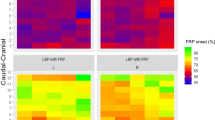Abstract
A surface EMG diagnostic protocol was developed to assess the neuromuscular/postural contributions to pain states. The EMG activity of the right and left aspects of 11 muscle groups were monitored while the patient was in the sitting and standing positions. The diagnostic protocol was evaluated by comparing the patterns of EMG activity in four diagnostic groups: headache only, neck/shoulder/upper back pain only, low back pain only, and mixed pain states. The results suggest that (1) bilateral levels of EMG activity in the frontalis and masseter groups are of primary importance for the headache patients, (2) the discrepancy between the right and left EMG activity in the lumbar and cervical paraspinal muscle groups are of primary importance for low back pain patients, (3) position (sit/stand) may provide important diagnostic information, and (4) the data appear to support the notion of a postural disturbance as a contributing factor in low back pain.
Similar content being viewed by others
References
Belar, C., & Cohen, J. The use of EMG biofeedback and progressive relaxation in the treatment of a woman with chronic back pain.Biofeedback and Self-Regulation. 1979,4(4), 345–353.
Budzynski, T., Stoyva, J., Adler, C., & Mullaney, E. EMG biofeedback and tension headaches: A controlled outcome study.Psychosomatic Medicine 1973,35(6), 484–496.
Cram, J. R. EMG biofeedback and the treatment of tension headaches: A systematic analysis of treatment components.Behavior Therapy 1981,11 699–710.
DeBacher, G. Biofeedback in spasticity control. In J. J. Basmajian (Ed.),Biofeedback principles and practice for clinicians. Baltimore: Williams and Wilkins, 1979. Pp. 61–80.
Donisch, E., & Basmajian, J. Electromyography of deep muscles in man.American Journal of Anatomy 1972,133 25–36.
Floyd, W. F., & Silver, P. The function of the erectors spinae muscles in certain movements and postures in man.Journal of Physiology 1955,129 184–203.
Fordyce, W. E.Behavioral methods for chronic pain and illness. St. Louis: C. V. Mosby, 1976,.
Harper, R., & Steger, J. Psychological correlates of frontalis EMG and pain in tension headache.Headache 1978,18(4), 215–218.
Haynes, S., Griffin, P., Mooney, D., & Parbe, M. Electromyograph feedback and relaxation instructions in the treatment of muscle contraction headache.Behavior Therapy 1975,6 672–678.
Hollinshead, W. H. Functional anatomy of the limbs and back. Philadelphia: Saunders, 1976.
Johnson, A. D.The problem claim: An approach to early identification. State of Washington: Department of Labor and Industries, 1978. (Mimeo)
Jones, A., & Wolf, S. Treating chronic low back pain.Physical Therapy 1980,60(1), 58–63.
Jonsson, B. The functions of individual muscles in the lumbar part of the erector spinae muscle.Electromyography 1970,10 5–21.
Joseph, J.Man's posture: Electromyographic studies. Springfield, Illinois: Charles C Thomas, 1960.
Kraus, H., & Raab, W.Hypokinetic disease. Springfield, Illinois: Charles C Thomas, 1961.
Kravitz, E., Moore, M., Glaros, A., & Stauffer, T. EMG biofeedback and differential relaxation training to promote pain relief in chronic low back pain patients.Proceedings of the Biofeedback Society of America, Alburquerque, New Mexico, 1978.
Nouwen, A., & Salinger, J. The effectiveness of EMG biofeedback in low back pain.Biofeedback and Self-Regulation 1979,4(2), 108–111.
Pauly, J. E. An electromyographic analysis of certain movements and exercises. Part I: Some deep muscles of the back.Anatomy Records 1966,155 223–234.
Sainsbury, P., & Gibson, J. F. Symptoms of anxiety and tension accompanying psychophysiological changes in the muscular system.Journal of Neurology, Neurosurgery and Psychiatry 1954,17 216–224.
Steger, J., & Harper, R. Comprehensive biofeedback versus self-monitored relaxation in the treatment of tension headaches.Headache 1980,20(3), 137–142.
Vaughn, R., Pall, M. L., & Haynes, S. N. Frontalis EMG response to stress in subjects with frequent muscle-contraction headaches.Headache 1977,16 313–317.
Wolf, S., & Basmajian, J. Assessment of paraspinal electromyographic activity in normal subjects and chronic back pain patients using a muscle biofeedback device. In E. Asmussen & K. Jorgensen (Eds.),International series on biomechanics (Vol. 6B). Baltimore: University Park Press, 1978.
Wolf, S., Nacht, M., & Kelly, J. EMG feedback training during dynamic movement for low back pain patients.Behavior Therapy 1982,13 395–406.
Author information
Authors and Affiliations
Additional information
This study was supported in part by Research Grant No. G008003029 from the National Institute of Handicapped Research, Department of Education, Washington, D.C. 20202.
Rights and permissions
About this article
Cite this article
Cram, J.R., Steger, J.C. EMG scanning in the diagnosis of chronic pain. Biofeedback and Self-Regulation 8, 229–241 (1983). https://doi.org/10.1007/BF00998853
Issue Date:
DOI: https://doi.org/10.1007/BF00998853




